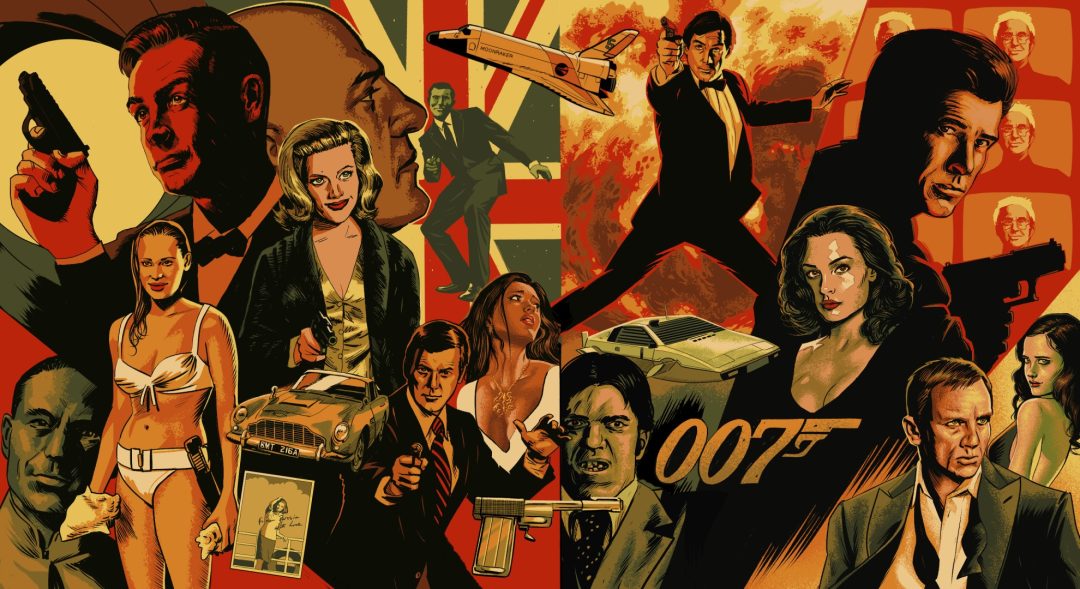Whenever we talk about James Bond, 007 here at Last Movie Outpost (the Fleming novels, the actors, or the continuation novels), somebody always says:
“Do the movies!”
Not an undertaking for the faint of heart. There are 25 movies, plus unofficial entries. These draw from more than 70 years of 007 history. There are nearly 50 novels. Six actors have taken on the role for Eon Productions. Each movie can be endlessly debated. If we are going to do this, take every James Bond movie in turn as part of a series at Last Movie Outpost, we need a team. I need help. I need an R2-D2 to my C-3PO, a Butch to my Sundance, a Q to my Moneypenny. In short, I need Wrenage – the only other Outposter with such a nerdy, detailed level of fascination for all things 007.
Wrenage is so excellently geeky about Bond that he has a spreadsheet rating all of the films across different categories. We will do that here. For each movie, we will compare our opinions of the film and score key Bondian ingredients. So strap in, because here we go! In the words of Princess Irulan – the beginning is a very delicate time…
Dr. No – Behind The Scenes
We talked about the book as part of our series on the Fleming novels. The story of the movie starts a few years later after Fleming wrote the outline of the story as Commander Jamaica for producer Henry Morgenthau III. This was a project to promote Jamaican tourism. The project fell through, so Fleming reworked it into Dr. No.
Shortly after completion, Fleming met with Canadian film producer Harry Saltzman about making a screen adaptation of this book. As a result, Fleming sold Saltzman the rights to all of the James Bond novels, except Casino Royale and Thunderball, for $50,000. Saltzman had the rights, but he couldn’t afford to get the project off the ground. Screenwriter Wolf Mankowitz introduced Saltzman to Albert R. “Cubby” Broccoli. Saltzman didn’t want to pass the rights on to Broccoli, however, so they formed a partnership.
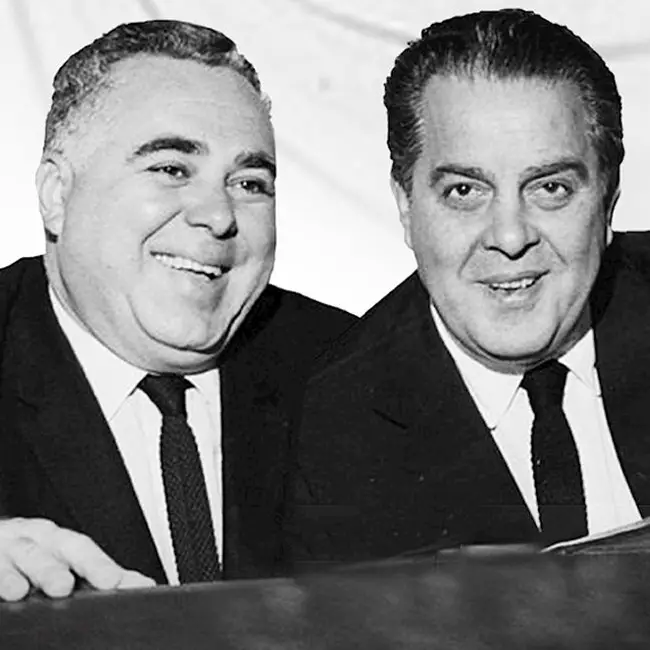
Their problems were not over, though. It is important to place Dr. No, and the Bond stories in general, within the context of the time. In the early 1960s, nothing like James Bond could be found in movie theaters. Lawrence Of Arabia was a sweeping epic. A black-and-white war movie, The Longest Day, would top the box office. Comedies such as A Touch Of Mink were commonplace. Serious drama fare like an adaption of To Kill A Mockingbird would sweep awards.
Escapism and espionage tinged with violence and raw sexuality were not an immediate draw. Indeed, back in the home of Bond, the British bien-pensant, bourgeoisie metropolitan Left was in thrall to an idolized and romanticized vision of glorious global socialism. To them, James Bond (and Ian Fleming himself) represented everything they despised. America was the enemy, not an ally.
Hollywood itself was similarly afflicted. A number of Hollywood film studios did not want to fund the films, finding them “too British” or “too blatantly sexual”. The books were considered sadistic in places. Concerns existed that the skittish censors of the day, much more chaste than now, would rip anything they created to shreds.
Eventually, United Artists stepped up and gave the green light to Dr. No for a 1962 release. Saltzman and Broccoli created two companies: Danjaq, which was to hold the rights to the films, and Eon Productions, which was to produce them. They had a princely budget of just $1.1 million. At the 1960s exchange rate, this was £392,022. That is about 80 times less than the price of a single episode of The Rings Of Power.
Given how Hollywood usually works, Saltzman and Broccoli’s meeting with United Artists was amazing in and of itself. They struck a deal in an hour without putting pen to paper. They simply shook hands. According to David Picker, former President of United Artists:
“In those years, when you made a deal with someone, you would finance a movie, distribute the movie, pay the bank losses, pay the profits, if there were any, without a signed piece of paper. At least at United Artists you would because our word was all that was required.”
United Artists then let Saltzman and Broccoli make their movie, trusting them to do the job right. Saltzman and Broccoli just needed a Bond. Cary Grant was best man at Broccoli’s wedding, but Saltzman and Broccoli knew it would only be one film with Grant. They had bigger aspirations, so they needed to look somewhere else…
Do You Expect Us To Talk?
Stark: Well, where to even begin with Dr. No. As we said in the behind-the-scenes section above, context is important. I spoke to both my parents about this movie in the past. They were both in their late teens or early twenties when it was released. They confirm it was like nothing else they had ever seen back then.
Wrenage: To me, Dr. No is an outlier in my Bond movie pantheon. In The Fly, Jeff Goldblum has a third telepod that sits in the corner – a prototype. “Clunky but it works”. That’s how I view Dr. No. The film establishes the template that subsequent Bond movies were built upon and streamlined into a slick machine.
Stark: The budget didn’t help. $1 million was small even back then for a picture of this size. I remember an interview with Ken Adam (Production Designer) where he talks about all of the shortcuts he had to take, like rear projection. United Artists UK had to chip in with an additional $100k just to do the base-exploding scenes at the end. I find some of that clunkiness charming.
Despite this, Dr. No contains some truly excellent scenes. Bond’s intro remains one of the coolest things in cinema history, and the execution of Professor Dent is top-tier:
“That’s a Smith & Wesson, and you’ve had your six.”
Wrenage: We are only passing through history, but James Bond’s introduction – that is history. If there is a man who hasn’t riffed on the “Bond, James Bond” line, I have not met him. For this reason, Bond is the first element we will look at when grading these films.
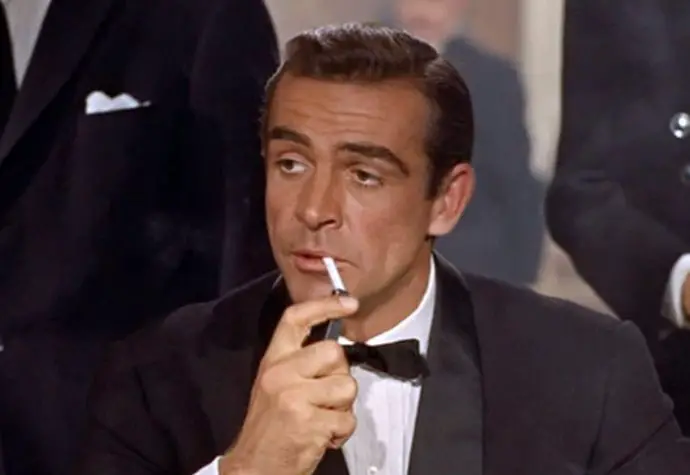
Bond
Stark: Potentially the greatest accidental casting in cinema history? The director of Dr. No wanted Richard Johnson. Patrick McGoohan and David Niven were also discussed. Some claim Fleming wanted Richard Todd. Others say Edward Underdown. It’s clear Fleming didn’t like the idea of Connery. Broccoli thought about Roger Moore but considered him “..too young, perhaps a shade too pretty,” even though he was older than Connery.
At the time, Connery had stage credits, a couple of screen credits, and the lead role in Darby O’Gill and the Little People. Who would have thought of him as Bond? Now, in hindsight, it was perfect casting.
Wrenage: Connery’s Bond comes out of the gates fully-formed. Dry humor and flippant attitude toward death? Check. As a car plummets off the side of the road and bursts into flame, Bond remarks, “I think they were on the way to a funeral.” Ruthlessness? Check. Bond shoots the aforementioned Professor Dent in cold blood. Meanwhile, the veneer of sophistication is also in place.
It’s easy to give all credit to Connery, but director Terence Young also played an important role in creating the cinematic Bond. Young took Connery to a tailor to get the right clothes. Young set Connery up with the right accessories. Those close to the production said Young taught Connery everything about the sophistication side of the coin.
A quote exists from Terence Young that gives insight into his personality. “Any damn fool can be uncomfortable.” This is seen in the Bond character, as well. He always has the best clothes, the best cars and stays in the best hotels.
Despite hitting the ground running as a character, Bond is hampered by “first film blues” in Dr. No. The movie’s plot doesn’t give him a lot of room to spread his wings. Dr. No was chosen as the first book to adapt because producers deemed it the easiest. They had to learn to walk before they could run.
Stark: One thing is absolutely clear, though. You could tell you were watching a movie star in the making with Connery from his first moment on screen.
Wrenage: Broccoli said one of the reasons he went with Connery was because “he moved well onscreen.” The camera loves some people. Connery is one of them. Drunken Yoda is the other…
Stark: There are different versions of events around the final decision for Connery. Some claim Cubby’s wife persuaded him because she could tell he had magnetism and sexual charisma. Other stories say that he was quite stand-offish with Saltzman and Broccoli during discussions and they liked that, and they watched him walk to his car from their office window and noted how he carried himself. It feels like it was a combination of a few things.
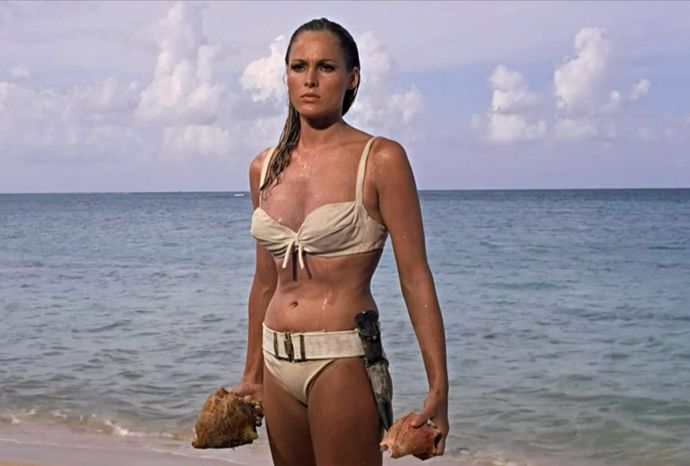
Bond Girl
Wrenage: When I think of the phrase “bikini woman,” two images come to mind. First, Raquel Welch from 1,000,000 Years B.C. Next, Ursula Andress emerging from the ocean in Dr. No. Despite establishing iconography, Ursula does little else in Dr. No. In the book, she at least gets attacked by crabs (the ocean kind). The most Ursula does in the movie is sing Underneath the Mango Tree. Terence Young did try to get the crab-attack scene on film, but it proved to be a disaster and was scrapped in editing.
Stark: I often point to Honey Ryder whenever the tiresome judging of Bond girls comes up. She is no victim. She is not helpless. She understands the flora and fauna of the island better than Bond. She’s been standing on her own for her entire life after killing her own rapist. She is no damsel in distress.
Wrenage: Absolutely. Viewers have no problem identifying Honey Ryder as a strong character, despite the fact the movie never gives her a Rey Skywalker moment or a cringe-worthy line cribbed from a feminist manifesto.
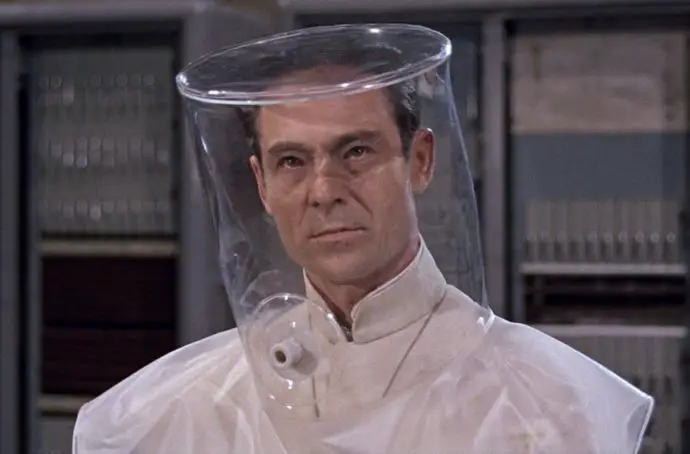
Villain
Wrenage: Joseph Wiseman is underused as Dr. No. He doesn’t appear until the last half hour. His plan is not all that epic either. He wants to disrupt America’s space program with radio beams to demonstrate SPECTRE’s power.
Nevertheless, Wiseman sets the template for Bond villains. He has a lair. He has a (somewhat) grandiose plan. He has metal hands. Wiseman is put in Asian face and does an adequate job with the small amount of material he is given. He manages to be chilling with his calm, self-possessed demeanor. A Hannibal Lector-quality exists in his performance.
Stark: In the book, his plan is even less. He was just toppling the missiles being tested from Florida, nothing to do with the space program. That was a time-relevant change by the producers to bring in space exploration. Dr. No is more of a presence than a nemesis in the movie. Looking back it seems weird to introduce SPECTRE through an operative rather than Blofeld himself, but then I remember in the book he’s a standalone villain, isn’t he? Nothing to do with SPECTRE or SMERSH?
Wrenage: I am ashamed to admit, I always thought the term SMERSH was a parody of SPECTRE that came from the Peter Sellers version of Casino Royale. It is only recently that I realized SMERSH is a legitimate Bond term.
Stark: Oh… Not just a Bond-thing, but an actual thing-thing! SMERSH is the acronym for the Russian words “Death to spies,” which was the name of the Soviet counterintelligence organization dedicated to the elimination of anti-communist activity during the Second World War. The name SMERSH was coined by Joseph Stalin himself! Its job was originally to subvert the attempts by Nazi German forces to infiltrate the Red Army on the Eastern Front.
SMERSH was the primary villain in almost all of the Bond books and has a vendetta against Bond after he thwarts so many of their schemes over the course of the early novels. All you hear about is SPECTRE, due to the movies, but SPECTRE only appears in the Blofeld trilogy towards the end of Fleming’s run in the books. Other than that, it’s SMERSH all the way. The movies made SPECTRE a thing.
Wrenage: I want you on my trivia team, you magnificent, beautiful creature of knowledge.
Stark: Because my head is full of shit like this, there is no room in there for anything important.
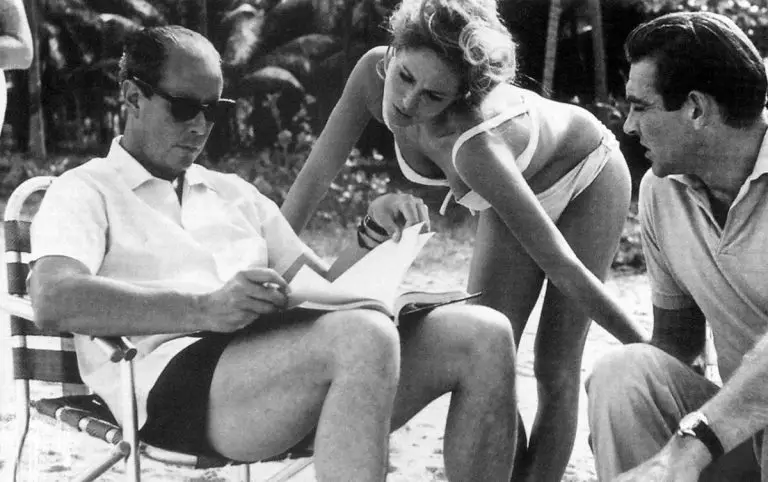
Plot
Wrenage: The plot meanders. Jamaican MI6 operatives are killed. Bond investigates. Felix Lighter, Bond’s CIA friend, is introduced. Something about radioactive minerals leads them to an island. The story is talk-heavy, and the island infiltration is slow.
Dr. No gets by on style. Terence Young was an old-school professional. Even if nothing is happening, production value oozes from the screen. It’s also time to bring cigarette smoke back to movies. Sure, it’s bad for you, but it looks great!Stark: I don’t find the plot meandering at all. It’s straightforward. “A” leads directly to “B” and then onto “C”. It’s a classic investigation story that reveals something bigger. It’s refreshingly clean.
Action
Wrenage: Dr. No being short on various elements is my common refrain. Action is no different. The movie has a car chase…sort of. The chase is mostly Bond escaping rear projection. He drives under a crane to escape his pursuer, which is also rear projection and awkward. Some fisticuffs happen. A clumsy miniature blows up. For some reason, taking on a tank with a pair of pistols is deemed a good plan.
Stark: The tight budget, and how they made it look more expensive than it was, is legendary. Ken Adam pulled off miracles. I found an old interview with him about this:
“The budget for Dr No was under $1m for the whole picture. My budget was £14,500. I filled three stages at Pinewood full of sets while they were filming in Jamaica. It wasn’t a real aquarium in Dr. No’s apartment.
It was a disaster to tell you the truth because we had so little money. We decided to use a rear-projection screen and get some stock footage of fish. What we didn’t realize was because we didn’t have much money the only stock footage they could buy was of goldfish-sized fish, so we had to blow up the size and put a line in the dialogue with Bond talking about the magnification. I didn’t see any reason why Dr. No shouldn’t have good taste so we mixed contemporary furniture and antiques.
We thought it would be fun for him to have some stolen art so we used Goya’s Portrait of the Duke of Wellington, which was still missing at the time.
I got hold of a slide from the National Gallery – this was on the Friday, shooting began on the Monday – and I painted a Goya over the weekend. It was pretty good so they used it for publicity purposes but, just like the real one, it got stolen while it was on display.”
Wrenage: Bond also has a token escape from his prison cell. This sequence harkens back to the book, I believe. Stark can tell us more about this since he knows the books as well as a carpenter knows his hammer. I believe the Bond books are required reading for British children, along with How to Eat Beans for Breakfast. In the book, the sequence ends with Bond battling a giant squid. In the movie, Bond merely has to contend with some hot pipes and running water.

Stark: The book sure does have a giant squid! Dr. No was the sixth book and it really shows Fleming’s inability to avoid lapsing into pulp. The giant squid is a fun sequence though. I imagine it would have looked as hokey as the 20,000 Leagues Under The Sea effort onscreen, though. Dr. No might not have recovered or earned a sequel if it had James Bond battling a rubbery giant squid in Act III.
Wrenage: Despite lackluster action, we must note another person instrumental in establishing the Bond aesthetic – editor Peter Hunt. Prior to Dr. No, a general rule of thumb when editing was “do not cut on movement.”
Peter Hunt said the heck with that and edited in a way that brought a more fluid approach to action films. This style has now evolved to the point where people like Michael Bay have never met an action cut they didn’t like. Hunt was so instrumental in shaping the early Bond films that he eventually got to direct one himself.
Stark: It’s important to realize how intrinsic these stylistic decisions are in Bond being Bond on-screen, and how you can spot it a mile away when they are missing. Latter Pierce Brosnan movies, I am looking at you! Dr. No has these characteristics in droves. The sheer style, as you say, papers over almost all the other cracks.
Pre-title
Wrenage: A pre-title sequence is not applicable to Dr. No. We get a prototype of Bond opening credits instead. Maurice Binder did the opening credits on the first 16 Bond films. These sequences are as much a part of Bond as vodka martinis. As soon as lady silhouettes dance to a theme song, you know you’re in for a fun ride.
Stark: I went in a different direction with my grading and considered the assassination of Strangways and his secretary as a replacement for a pre-title sequence. I love everything that follows it. The so-very 60s radio room at MI6, the first glimpse of M’s office, the London casino. Everyone talking in clipped, correct pronunciation tones. In my head, you could break for the opening titles as Bond leaves the casino to return to the office.
Wrenage: Maurice Binder is also responsible for the gun-barrel sequence. It is not an optical. Binder used a pinhole camera in a gun barrel. For the first film in a series, it is amazing how many elements they established as staples of the Bond films.
Stark: All part of that style again. It’s one reason for the longevity of the franchise because Bond films have a distinctness others try and copy, but just can’t get right.
The gun barrel is interesting to me, in that the first appearance of Bond onscreen isn’t Connery at all. Stuntman Bob Simmons does the gun barrel for the first three Bond movies. Connery isn’t at the end of it until Thunderball!
Theme Song
Stark: I scored the theme song as “N/A” because I wasn’t going to count Three Blind Mice as a Bond theme!
Wrenage: No theme song exists in Dr. No, per se, but it does include the Bond theme itself. For this reason, I have to give it a 10/10. The Bond theme is maybe as famous as the Jaws theme. Monty Norman based the Bond theme around one of his previous works written for the musical A House for Mr. Biswas. Only as time ran out, did Bond composer stalwart John Barry come in to help finish the film.
Stark: Have you heard it with the lyrics from Good Sign / Bad Sign from A House For Mr Biswas sung over it? Weird… but it does work!
X-Factor
Wrenage: Since Dr. No is the first film in the series, that is a pretty big X-factor, so it deserves the highest score possible.
Aside from Young and Hunt, another man integral in establishing the Bond brand must be mentioned – Ken Adam. Adam worked on Bond movies up to Moonraker, and his gonzo design style is evident in all of the crazy villain lairs, M offices, and more.
The room where an assassin receives a tarantula from Dr. No stands out. It has a small chair and table, while the room itself is overly-large. A gridded circular skylight illuminates the scene and creates a completely unique environment. These types of designs are characters in and of themselves. They create a world of hyper-reality that makes all of Bond’s wackiness reasonable.
Stark: Is it that wacky though? There are a lot of 60s design cues in Dr. No. At the time a lot of this stuff was simply very stylish and up-to-date.
Wrenage: I am from the Midwest, USA. The picture below is all I know of style. Anything more than that is wacky to my stunted brain.
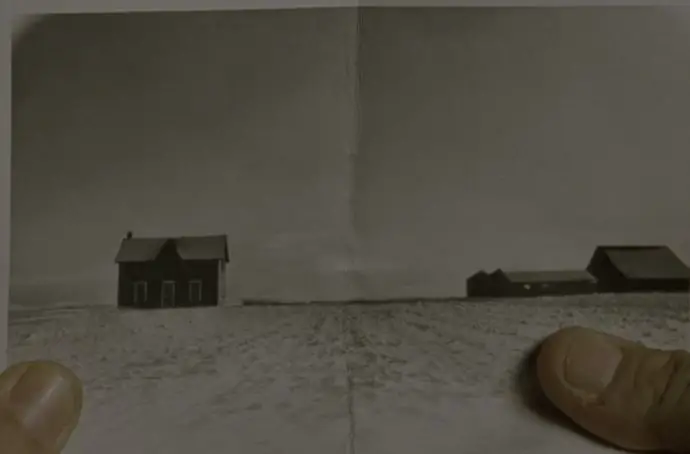
Stark: I would love nothing more than to convince you that all Brits are as suave and stylish and matinee-idol handsome as Connery in a Bond movie, but alas you would know I was lying.
Final Scores
Now that we have given our thoughts on the common Bondian elements contained in Dr. No, we will assign each one a score of 1-10.
| Stark | Wrenage | |
| Bond | 8 | 7 |
| Bond Girl | 7 | 6 |
| Villain | 7 | 6 |
| Plot | 8 | 5 |
| Action Sequences | 6 | 5 |
| Pre-Title Sequence | 6 | N/A |
| Theme Song | N/A | 10 |
| X-Factor | 8 | 10 |
| TOTAL | 50 | 49 |
Wrenage: Even though we came at the movie with slightly different perspectives, we still arrived at almost the same score. You seem to enjoy Dr. No more as a movie, and I seem to enjoy Dr. No more as an artifact.
Stark: I think Dr. No is a very well-made spy movie that then develops nicely into more fantastical elements in Act III. It’s still highly watchable, to me. When I channel hop and find it on, I always stop and watch it.
Brackets
Ranking the James Bond movies in order is so subjective that it is a waste of time. Instead of setting off on this fool’s errand, we will bracket them. The rules are simple. With 25 official movies (and counting) there will be between 6 and 7 movies in each tier. Once that tier is full, we will need to push a movie down a tier to squeeze another entry in.
Right now this will be easy, as Dr. No is the first cab off the rank, and the tier buckets are empty. By the time Roger Moore rolls around, this could be where epic arguments begin.
Stark: Easy decision so early on. Dr. No is the movie that started it all, and it still stands up today. Top tier easily.
Wrenage: Despite having to give Dr. No some average scores for objective reasons, it is still a subjectively charming movie to me. Bond has given me a lot of enjoyment through the years, and none of it would have been possible without Dr. No paving the way.
Top Tier:
Dr. No (49.5)
Second Tier:
Currently empty
Third Tier:
Currently empty
Bottom Tier:
Currently empty
So there you have it. The first James Bond movie in the franchise… done. Let’s see where we go from here. Next time, From Russia With Love.
Check back every day for movie news and reviews at the Last Movie Outpost


